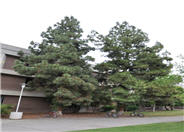
Common name:Canary Island Pine
Botanical name:Pinus canariensis
This graceful, slender-growing pine has a pyramidal form to about 70'. Its needles are long and drooping in bundles of 3. The foliage is a blue-green color, maturing to a dark green shade. Needles can grow to 12" long. Flowers are insignificant. Cones appear in the spring.
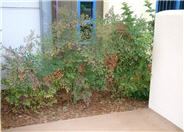
Common name:Nandina, Heavenly Bamboo
Botanical name:Nandina domestica
Nandina domestica is a graceful upright shrub that grows from 3'-6' in height. It gets its name from its bamboo-like growth habit. When thinned from the center it bears a remarkable resemblance to bamboo. It is best used in groups. It can be used in a shaded patio or out in a shrub border with full sun. An interesting feature of Heavenly Bamboo is the bronze color in the new growth when planted in full sun. It also bears clusters of white flowers in the spring.
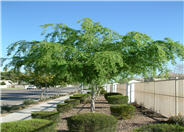
Common name:Chinese Elm, Chinese Evergreen Elm
Botanical name:Ulmus parvifolia
Chinese Elm quickly reaches 50' tall and 60' wide with an upright habit and spreading pendulous branches with age. Chinese Elm has small, dark green leaves. Foliage turns yellow or orange in fall. Small, greenish yellow flower appear in summer but are considered insignificant. Small light brown fruit appear in fall but are not noticeable. Bark is brown gray but with maturity, exfoliates to reveal orange patterns.
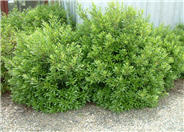
Common name:Pacific Wax Myrtle
Botanical name:Myrica californica
This large shrub-tree can reach 30' tall and has glossy, dark green leaves with purple nutlets that attract birds. Used very effectively as a screen.
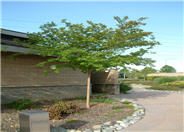
Common name:Crape Myrtle
Botanical name:Lagerstroemia indica
The new leaves of this species are 2" long, bright green, and tinged with bronze. Some cultivars have spectacular fall color. When it has a bare outline, its rounded seed capsules add interest. Its delicate flowers bloom in 6"-12" long clusters. The flower colors could be shades of red, rose, pink, purple, and white, blooming in summer. It thrives on heat, and new cultivars have been created that resist mildew. This tree prefers full sun and has low watering needs once it's established.
The natural world works in cycles. Everything is changing form and moving from place to place in an endless energy exchange system. The leaves and twigs that fall to the ground, not to mention other life forms that might die, decompose and combine with water, air and minerals of the soil to create a medium for future plants.
Click in the green box for more information
Click in the green box for more information
Designer: Jody Palmer
Photographer: GardenSoft
Maintain a two to four inch layer of mulch on the soil surface to reduce weeds, infiltrate rain water, and reduce compaction.
Drip and other smart irrigation delivers water directly to roots, allowing no excess water for weeds.